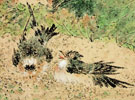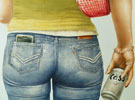The Cruelty of Humanness
Written on the occasion of Wim Delvoye’s solo exhibition at Galerie Urs Meile
Text: Carol Yinghua Lu
If we could partially gauge an artist’s worldview from his or her art, there is little romance to be derived from Belgium artist Wim Delvoye’s prospect. Neither is there room for hypocrisy in his work. As viewers, we have no escape, but are instead confronted with what Delvoye (*1965 in Wervik, Belgium) once described as “a cruelty of the body” in the ways he portrays and represents humanness - ways that are often blunt and blatant, lacking in subtlety or diplomacy.
He’s made friends perform explicit sexual acts in medical clinics and had them recorded with X-ray scans, which were then sandwiched between colored glass to make windows in the tradition of medieval stained glass. Instead of human flesh, you see skeletons engaging in kissing, fondling and pleasuring each other. It’s a rather unfamiliar sight, yet it’s both realistic and real. Delvoye runs a pig farm in Beijing and sells tattooed pigskins and stuffed, tattooed pigs. And above all, he has made machines that digest food and discharge excrement. “If you really want to show a portrait of mankind, you have to look for the humanness.” And for that matter, Wim Delvoye’s works revolve around two pivotal axes: “one is the world of the frieze - decorative, the elegance of arabesques; the other is excrement.” The artist, however, sees little difference between the two: “The ornament, to an extent, is a form of waste.”
Cloaca, probably by far Delvoye’s best-known work, is a large-scale installation that duplicates the functions of the human digestive system and exists in a variety of models and incarnations. To put it simply, Cloaca is a machine that eats and shits. When exhibited, regular food is prepared by chefs and fed regularly (usually twice a day) into the workings of the machine, or should we say, the human machine. It then dutifully extrudes the remaining solids onto a conveyer belt, which is finally vacuum-packed and sold in plexi cases for $1,000 each.
Cloaca was not simply a meditation on waste. The fact that a machine that produced shit was accepted and highly valued in the art circle was rather a provocation to an art world that had become increasingly commercialized since the mid-1990s, with the arrival of the Internet boom and dotcom economy. During an era when everything could potentially carry a price tag as an art object, Cloaca and its wide acceptance and popularity were a parody of the art system itself and what was considered valuable at the time. It mocked the very structure that supported its presentation and operation. Dan Cameron, former Senior Curator of New York’s New Museum has written of Cloaca, “by replicating one of our most crucial biological functions, Delvoye forces viewers both to consider our social discomfort with such functions and to question the elaborate cultural mechanisms that we have constructed to keep them from view.”
With another ongoing project, his “Pigskins” and “Stuffed Tattooed Pigs” series, Delvoye once again challenged the level of tolerance and the notion of worthiness in both the art system and our societies by tattooing patterns on live pigs and selling both tattooed pigskins and stuffed pigs as his artworks. His act of tattooing pigs has caused reactions and strong opposition from animal right activists in Europe, and he has since re-established a pig farm on the outskirts of Beijing, which he calls Art Farm. What makes the whole operation even more thought provoking is the fact that these art products are still exhibited and consumed in the international art context. While Delvoye found it impossible to continue having pigs tattooed without causing controversy in Western societies, does their status as artworks make the products of this operation immune to criticism and allow it to acquire a certain positive value within the system again? Delvoye, however, wouldn’t want us to continue turning a blind eye to the underlying currents of such a mechanism, and instead brings it to us without disguise. Art Farm is a documentary of the full operation of his pig farm in China, shot on video from three different angles. We can’t pretend to know the easy part - the beautiful pigskin - without knowing how it has been made. There is no illusion or mystery left.
In addition to the three-screen video projection of Art Farm and some of his tattooed pigskins, Wim Delvoye will also share with us various sardonic products of his confrontational engagements with the art world and society in his exhibition at the Beijing branch of Galerie Urs Meile, Beijing-Lucerne. In his incessant interrogation of the limits and accepted order of the art system, Wim Delvoye has proven himself capable of creating objects and sculptures that appear to be eye-catching and even ornamental, yet at the same time address important issues Delvoye would like us to think about as we attempt to understand how the art world operates and to consider the multiple facets of our own existence.
Clio (2001-2002) and Terpsichore (2001-2002) are among the selection of works presented in the exhibition. These two works come from a series of stained glass windows incorporating images of X-ray photographs of cavorting couples that is part of his body of “Gothic Works”. Named after the nine muses of Greek mythology - Greek goddesses that ruled over the arts and sciences and offered inspiration in those subjects - this series involves Delvoye’s friends performing sexual acts in medical X-ray clinics and being captured on X-ray film, reduced to nothing but pure mechanical and graphic patterns. Another important branch of Delvoye’s “Gothic Works” is also presented in Beijing with Concrete Mixer (scale model 1:4) (2010) and Cement Truck (scale model) (2008). They are steel sculptures with meticulously carved, Gothic-style patterns.
The notion of the interchangeable nature of what’s useful and what’s useless continues to inform Delvoye’s manipulation of used objects. He transforms things that seem useful in everyday life into purely decorative items that then carry a different value from their everyday uses. Such items then become less useful in a practical context, but they are assigned a visual and artistic value in the art context. He has used car tires handcrafted with intricate designs that turned them into purely beautiful objects.
With his work, Delvoye continuously exposes us to the humanness of both the physical body and our social structures, particularly those sides that are not always pleasant, warm or generally considered constructive, but are equally valid and relevant to our being. Delvoye makes bare the less visible threads of our social fabric by giving them a place in the art context, and grants them a cultural and thus monetary sense of worthiness, simultaneously contemplating and revealing the mechanisms of the cultural industry.
Loosely grouped to give a first impression of some of Delvoye’s important practices, this solo show offers barely the tip of the iceberg in terms of introducing the complex oeuvre of one of the most prolific artists of the last decade.










